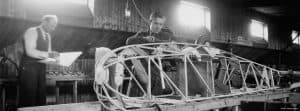The Lavin Agency Speakers Bureau
A speakers bureau that represents the best original thinkers,
writers, and doers for speaking engagements.
A speakers bureau that represents the best original thinkers,
writers, and doers for speaking engagements.
The third way of innovation is not radical disruption—it’s a low-risk, high-reward strategy.
We tend to imagine innovation as slow, incremental change or else industry-shifting disruption. Yet for most companies, neither works. In The Power of Little Ideas, MIT Sloan professor DAVID ROBERTSON outlines a third way of innovation—actual working strategies for world-class companies. Building on his groundbreaking study of Lego’s rise from near-bankruptcy, Robertson shows us the organizational practices that lead to sustained innovation.
“The story of how Lego came perilously close to disaster but then transformed itself into one of the most successful and innovative companies in the world serves both as an inspiration and an object lesson.” — Chris Anderson, author of The Long Tail
David Robertson has devoted his life to innovation, having studied, taught, and practiced the art of organizational change throughout his career. In his book The Power of Little Ideas, Robertson argues for a ‘third way’ of innovation: something between slow, incremental change and radical disruption. Instead, he champions a low-risk, high-reward strategy that calls for complementary innovations around a core product or service. As he explains, companies like Gatorade, Wegman’s, Novo Nordisk, Lego, Victoria’s Secret, and others were either tired, second to market, challenged by tough competition, or on their way to becoming a commodity. But each was able to expand and recover spectacularly by innovating around the box—creating ecosystems of products that made their central product or service irresistible to customers. Little Ideas is powerful, practical, cogent and necessary—and Robertson translates this transformative book into refreshingly useful keynotes.
In his previous book Brick by Brick, Robertson gave the definitive account of one of the most profound business transformations in recent memory. In 2003, Lego almost went bankrupt. The company failed to adapt to the revolutionary changes in children’s lives and began sliding into irrelevance. Advice from innovation experts almost led the company to ruin, and the future looked bleak for one of America’s most iconic brands. Why didn’t newly developed products and businesses—including theme parks, computer games, electronic toys, and clothing—save the company? The answer wasn’t just innovation—it was innovation management. Lego needed an entirely new system of processes, tools, roles, and policies that governed creative thinking. Once that was in place, the company re-emerged more powerful, resilient, and inventive than ever. Throughout Brick by Brick—named one of the Best Books of the Year by Fortune and Strategy + Business—Robertson presents the strategies Lego used to become a customer-driven, full-spectrum, open, and adventurous brand. “Any manager can learn from these lessons,” writes Forbes. And in his funny, fascinating, and often interactive talks, he makes Lego’s success a case study any company can use to grow and evolve—and become iconic.
Today, Robertson is a Senior Lecturer at MIT Sloan School of Management, where he teaches Product Development and Digital Product Management. Previously, he was a Professor of Practice at the Wharton School, where he hosted the podcast Innovation Navigation, in addition to teaching. He was previously a LEGO Professor of Innovation and Technology Management at Switzerland’s Institute for Management Development (IMD), which received the #1 worldwide ranking by The Financial Times for its executive education programs. Robertson currently serves as a consultant to companies on innovation and technology management issues. He holds a PhD from the MIT Sloan School.
David's talk stood out as one of the highlights of the event. One attendee said, "The Lego segment was outstanding. I could see the correlation of customer-centric vision and delivery of professional empowerment for all our customers. Bravo!"
IntuitDavid was able to tailor his talk to our group and facilitate an exercise after his talk that applied the ideas from his book to real issues that we're facing today. His talk was entertaining and thought-provoking, and the exercise after really helped to bring the lessons home to our group and apply the ideas from his books to our business.
NouryonAuthor of The Age of Cryptocurrency and Our Biggest Fight Co-Host of the Money Reimagined Podcast MIT Media Advisor

Global AI Advisor CEO & Co-Founder of XLabs and Ribo One of Forbes’ 30 Women in AI to Watch Artificial Intelligence Pioneer
CEO of Trend Hunter New York Times bestselling author of Create the Future
Author of The Age of Cryptocurrency and Our Biggest Fight Co-Host of the Money Reimagined Podcast MIT Media Advisor

First Deputy National Cyber Director for Technology and Ecosystem Security Former White House AI Council Member Former Google Global Head of Product Security Strategy

WIRED Global Editorial Director

Author of Grit, the #1 New York Times Bestseller | Pioneering Researcher on Grit, Perseverance, and the Science of Success

Pulitzer Prize-Winning Creator of The 1619 Project | Executive Producer of the Emmy Award-Winning 1619 Project Hulu Docuseries | MacArthur Genius
Nike's Former Chief Marketing Officer | Author of Emotion by Design

New York Times Bestselling Author Of All Boys Aren’t Blue and We Are Not Broken | Emmy Nominee | LGBTQIA+ Activist
CEO of The Atlantic | Former Editor-in-Chief of WIRED

Diversity has its benefits across any organization: increased productivity, faster problem-solving, higher employee engagement, and yes, even higher innovation. The question is, how can you harness the diversity in your organization to drive that coveted skill? In this speech, David Robertson–an innovation expert, MIT faculty member, and citizen of the Cherokee Nation–offers audiences practical and useful techniques to boost company-wide innovation. By focusing and amplifying the diverse skills, knowledge, and cultural backgrounds of your teams, you will find yourself with a variety of perspectives and worldviews, says Robertson. He will teach you not only how to cultivate those perspectives, but how to combine them in novel and unexpected ways to truly become an innovation leader, no matter the industry.

Leading a group through an innovation project is a challenging process that is much different than other types of work. The skills that let you succeed and rise in a company may not serve you well when you’re leading innovation, and can even lead you to make exactly the wrong decisions.
What makes this more complex is that there is no single approach to innovation. Sometimes you need to sail for blue oceans, while other challenges require you to adopt disruptive new technology. Sometimes all that’s needed is an incremental improvement to a current product line, but often you need to uncover latent needs through an intensive field research effort.
This workshop helps you understand the different types of innovation, when to use each, and how to lead a team through each. It will teach you a proven and dependable set of innovation techniques and give you a roadmap for putting them together. Through lectures, case studies, hands-on activities, and a smartphone-based simulation, you’ll learn a set of tried-and-true methods for leading innovation.
This interactive program, designed for team leaders, product managers, and also for the mid-level and senior managers who have to supervise them, will give participants a set of tried-and-true tools and techniques for leading innovation; a structured framework for applying those tools and techniques; and recommendations for changes in roles, processes, structure, and metrics to enable successful innovation.

Today, companies are often caught between two ways of ‘doing’ innovation. The first involves the incremental improvement of existing products, or simply spinning out another variant—but that rarely means breakthrough success. And the second means a radical, revolutionary disruption of your entire industry. But while thrilling, this is of course high-cost, high-risk, and rarely applicable for most organizations.
Now, in a talk based on his new book The Power of Little Ideas, David Robertson outlines a third way. Rather than thinking too narrowly, or too disruptively, great companies innovate around the box. This means surrounding your key products—what made you great in the first place—with complementary innovations, or a supportive ecosystem of goods that broaden your appeal but don’t alter your central services or values. Gatorade did it by offering products meant for consumption before, during, and after performance—not by extending its range of flavored drinks. Victoria’s Secret did it by expanding into swimwear, CDs, fragrances and toiletries—not by releasing yet another bra. With reference to these, and other companies that get it—Disney, GoPro, Red Bull, Apple, Amazon, LEGO, and more—Robertson outlines the profound changes you’ll need to make to your internal processes, structure, rewards, roles, and systems to pull it off. Innovation can be logical, sustainable, and reliable. And with Robertson, you can foster a low-risk, high-reward strategy for practical change—and channel the little ideas that lead to big things.


Managers are bombarded with dozens of theories about how to manage innovation. These theories all promise growth and profits, but the actual results are less positive. Using the case study of LEGO, David Robertson’s keynote explores how to manage innovation across a company.
In 2003, LEGO almost went bankrupt. LEGO’s managers had followed the advice of experts—“head for blue ocean,” “practice disruptive innovation,” “open innovation,” “develop the full spectrum of innovation”—and that advice almost led them to ruin. Challenging their designers to think “out of the box” almost put them out of business! In one of the most successful turnarounds in modern business history, LEGO restructured its innovation management system and saved the company. Today, LEGO is the most profitable and fastest growing company in the toy industry, growing sales at 22% and profits at 38% per year every year for the past six years.